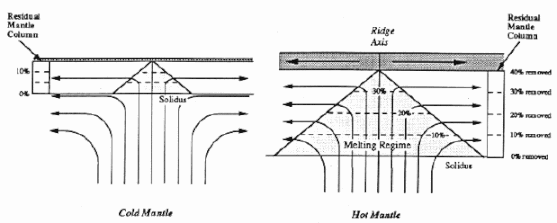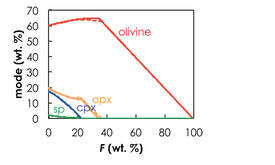 Triangular melting regimes of Langmuir et al. (1992)
Triangular melting regimes of Langmuir et al. (1992)
My research group's current research efforts in geochemical modeling focus on the design and implementation of new open-source, publicly available model calculation tools to determine and interpret the chemical and isotopic composition of magmas.
Part of our work is in collaboration with the ENKI project and has led to the development of the program pyUserCalc with Dr. Marc Spiegelman at LDEO. The primary model is a python script that determines U-series isotopes in lavas, based on initial parameters for decompression and partial melting of mantle rocks. To read about the model in detail, our accepted manuscript is publicly available as a Jupyter notebook that executes the model code. The full code is available in the ENKI public data repository on GitLab, and can be run using the ENKI cloud server by joining and logging into the ENKI JupyterHub environment. (To join, you will need a GitLab user account.) Recent additions to this melting software package include traditional dynamic melting, for a direct comparison with equilibrium and disequilibrium porous flow models, as well as 2-dimensional integration with radioactive decay during melt transport.
My group currently plans several expansions to the existing pyUserCalc code over the next few years. We are currently working on calculations to determine stable element concentrations and trace element ratios during melting, along with U-series isotopes.
We are also building a tool for determining pyroxenite melting behavior and bilithologic mantle melting, based on the work by and in collaboration with Dr. Sarah Lambart at University of Utah in her 2016 paper. We hope to work with Sarah to write an open-source program that would determine the results of her Melt-PX model calculator: this would be a python program that can be accessed via a Jupyter notebook or python script, and that can determine the degrees of melting during decompression of a 2-lithology mantle.
 MELTS model results for coexisting mantle lithologies, used together with Melt-PX in Lambart (2017).
MELTS model results for coexisting mantle lithologies, used together with Melt-PX in Lambart (2017).
Relatedly, many thermodynamic calculations of mineral stability and partial melting rely on the MELTS family of models, which are currently being updated and implemented within the ENKI open-source code project. We hope to directly integrate the Melt-PX model with a method to access and use MELTS and determine the mineralogy of peridotite rocks coexisting with pyroxenites in the mantle during melting, as a single, straightforward workflow. This effort would use Python and Jupyter methods, similar to the efforts above, and would essentially reproduce the methods of Lambart (2017).
Our pyUserCalc efforts to-date have included development of a new U-series isotope calculation tool that assumes chemical equilibration between liquid and solid occurs at a limited rate during melting. This chemical equilibration rate is expressed in comparison to the solid decompression rate of the mantle, using a Damköhler number, simulating processes such as slow elemental diffusion through solid rocks. This new chemical disequilibrium calculation method can be expanded to explore further effects of slow and differential elemental diffusion on the melting process, and on the compositions of the final lavas produced. This effort is planned for the near future.
Others in our research group are exploring the origins of statistical patterns in the global oceanic basalt database, and what they might imply for the characteristics and distributions of mantle heterogeneities. This more empirical modeling approach incorporates new statistical modeling methods and builds on the recent work of Stracke (2021).


